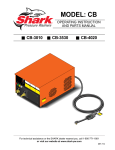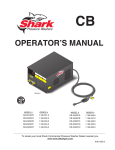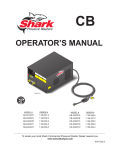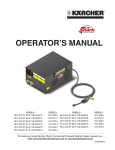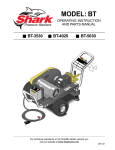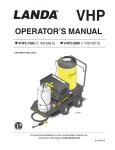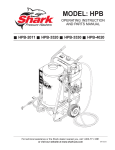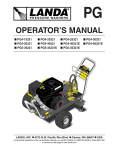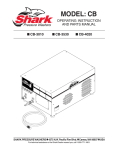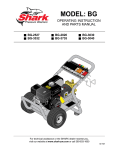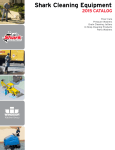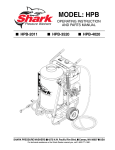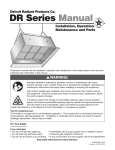Download Shark HNG-5030 Operator`s manual
Transcript
HNG OPERATOR’S MANUAL ■ HNG-4020 ■ HNG-3530 ■ HNG-5030 For technical assistance or the SHARK dealer nearest you, visit our website at www.shark-pw.com 97-610 CONTENTS Introduction & Important Safety Information 5-6 Component Identification 7 Installation 8 Installation Guide 9-12 Check List Before Starting 12 Assembly Instructions 13 Operating Instructions 14 Detergents & General Cleaning Techniques 15 Shut-Down & Cleanup 16 Storage 16 Basic Facts 17 Troubleshooting 18-19 Maintenance & Service 20-23 Heating Coils 20 Propane Gas 21 Burner Features 21-22 Burner Troubleshooting 22-23 Preventative Maintenance Schedule & Oil Change Record 24 Hose & Spray Gun Assembly 25 Exploded View, Left Side 26 Exploded View, Right Side 27 Exploded View, Parts List 28-29 Float Tank Assembly 30 Burner Assembly, Exploded View 31 Burner Assembly, Exploded View, Parts List 32 Control Panel 33 Control Panel, Parts List 34 Electrical Box, Standard, Parts List 35 Electrical Box, Time Delay 36 3 SHARK HNG • 97-610 • REV. 1/05 CONTENTS Electrical Box, Time Delay, Parts List 37 Electrical Box, Auto Start 38 Electrical Box, Auto Start, Parts List 39 Specifications 40-41 Warranty Model Number ______________________________ Serial Number ______________________________ Date of Purchase ____________________________ The model and serial numbers will be found on a decal attached to the pressure washer. You should record both serial number and date of purchase and keep in a safe place for future reference. 4 SHARK HNG • 97-610 • REV. 1/05 Thank you for purchasing our Pressure Washer. This manual covers the operation and maintenance of the 301007D, 352007A, 402007A, 402007B, 402007C, 502007A, 502007B, 502007C, 353007A, 353007B, 353007C, 503007B and 503007C model washers. All information in this manual is based on the latest product information available at the time of printing. We reserve the right to make changes at any time without incurring any obligation. 3. Know how to stop the machine and bleed pressures quickly. Be thoroughly familiar with the controls. 4. Stay alert. Watch what you are doing. WARNING Owner/User Responsibility: The owner and/or user must have an understanding of the manufacturer’s operating instructions and warnings before using this pressure washer. Warning information should be emphasized and understood. If the operator is not fluent in English, the manufacturer’s instructions and warnings shall be read to and discussed with the operator in the operator’s native language by the purchaser/owner, making sure that the operator comprehends its contents. Owner and/or user must study and maintain for future reference the manufacturers’ instructions This manual should be considered a permanent part of the machine and should remain with it if machine is resold. When ordering parts, please specify model and serial number. RISK OF EXPLOSION: DO NOT SPRAY FLAMMABLE LIQUIDS. WARNING WARNING: Flammable liquids can create fumes which can ignite causing property damage or severe injury. 5. Risk of explosion - Do not spray flammable liquids or operate in an explosive location. Operate only where open flame or torch is permitted. WARNING: Keep water spray away from electrical wiring or fatal electric shock may result. Read warning tag on electrical cord. 6. To protect the operator from electrical shock, the machine KEEP WATER SPRAY AWAY FROM must be electrically grounded. ELECTRICAL WIRING. It is the responsibility of the owner to connect this machine to a UL grounded receptacle of proper voltage and amperage ratings. Do not spray water on or near electrical components. Do not touch machine with wet hands or while standing in water. Always disconnect power before servicing. IMPORTANT SAFETY INFORMATION WARNING: Spray gun kicks back. Hold with both hands. WARNING: When using this machine basic precautions should always be followed, including the following: 7. Grip cleaning wand securely with both hands before starting the cleaner. Failure to do this could result in injury from a whipping wand. CAUTION CAUTION: To reduce the risk of injury, read operating instructions carefully before using. 1. Read the owner's manual thoroughly. Failure to follow instructions could cause malfunction of the machine and READ OPERATOR’S MANUAL result in death, serious bodily THOROUGHLY injury and/or property damPRIOR TO USE. age. 2. All installations must comply with local codes. Contact your electrician, plumber, utility company or the selling distributor for specific details. OPERATOR’S MANUAL This machine was designed for maximum use of 4 hours per day, 5 days per week. To comply with the National Electrical code (NFPA 70) and provide additional protection from risk of electric shock, this pressure washer is equipped with a UL approved ground fault circuit interrupter (GFCI) power cord for machines rated 250V 30 amp or less, single phase. PRESSURE WASHER INTRODUCTION & SAFETY INFORMATION WARNING WARNING: Equipment can produce a high pressure stream of fluid that can pierce skin and its underlying tissues, leading to serious injury and possible amputation. RISK OF INJECTION OR SEVERE INJURY TO PERSONS. KEEP CLEAR OF NOZZLE. 8. High pressure developed by these machines can cause personal injury or equipment damage. Use caution when operating. Do not direct discharge stream at anyone or at any part of the body, or severe injury or death will result. This machine is to be used only by qualified operators. 5 SHARK HNG • 97-610 • REV. 1/05 PRESSURE WASHER OPERATOR’S MANUAL INTRODUCTION & SAFETY INFORMATION CAUTION: Hot discharge fluid. WARNING Do not touch or direct discharge WARNING stream at persons. 9. Never make adjustments on machine while in operation. EXTREMELY HOT: USE CAUTION WHEN OPENING LID. WARNING PROTECTIVE EYEWEAR AND CLOTHING MUST BE WORN. WARNING RISK OF ASPHYXIATION. USE ONLY IN A WELL VENTILATED AREA. RISK OF FIRE. DO NOT USE WITH FLAMMABLE LIQUIDS. WARNING: High pressure can cause paint chips or other particles to become airborne and fly at high speeds. 10. Eye safety devices and foot protection must be worn when using this equipment. WARNING: Use only vapor propane fuel. 21. This equipment is designed to run on vapor fuel. Do not use liquid fuel. Have a qualified serviceman install and service your equipment. 22. Never expose a spark or flame where unburned gas may be present. 23. Never attempt to light pilot unless pilot manual valve has been shut off for 5 minutes. 24. A conversion kit, as supplied by the manufacturer, shall be used to convert natural gas to propane. WARNING: Risk of asphyxiation. Use this product only in a well ventilated area. 25. L.P. gases are heavier than air and will spill out on the floor. Therefore always provide adequate space and ventilation around these machines. Install machine 18" above the floor. 26. Manufacturer will not be liable for any changes made to our standard machines, or any components not purchased from the manufacturer. 11. When the machine is working, do not cover or place in a closed space where ventilation is insufficient. 27. Do not overreach or stand on unstable support. Keep good footing and balance at all times. 28. Follow maintenance instructions specified in the manual. 12. Machines with spray guns should not be operated with the trigger in the off position for extensive periods of time as this may cause damage to the pump. 13. Protect from freezing. 14. Be certain all quick coupler fittings are secured before using pressure washer. 15. Do not allow acids, caustic, or abrasive fluids to pass through the pump. 16. Inlet water must be cold and clean fresh water. 17. To reduce the risk of injury, close supervision is necessary when a machine is used near children. Do not allow children to operate the pressure washer. This machine must be attended during operation. WARNING RISK OF EXPLOSION: IF GAS SMELL PRESENT TURN OFF SUPPLY 29. When making repairs disconnect from electrical source and shut off gas valve. 30. Turn burner off, open spray gun and cool to 100° F before turning machine off. 31. Extinguish any open flame and test all joints with a soap solution. If odor persists, call your gas supplier immediately. 32. Not suitable for connection to Type B gas vent if the stack temperature exceeds 243° C (470° F). 33. A draft diverter shall be installed if this machine is going to be permanently installed and vented to the outside of the building. 18. The best insurance against an accident is precaution and knowledge of the machine. 19. Do not operate this product when fatigued or under the influence of alcohol or drugs. Keep operating area clear of all persons. 20. Do not replace LP tank while machine is running. Serious injury could result. 6 SHARK HNG • 97-610 • REV. 1/05 PRESSURE WASHER COMPONENT IDENTIFICATION Main Gas Supply Inlet 1/2 psig OPERATOR’S MANUAL Wand Quick Coupler Spray Wand Spray Gun Detergent Valve Pressure Nozzle Trigger Burner Switch Water Supply Hose (not included) Pump Switch Detergent Bucket (optional) High Pressure Hose Pump — Develops high pressure. Pump/Burner Switch— Controls operation on machine. Spray Gun — Controls the application of water and detergent onto cleaning surface with trigger device. Includes safety latch. Detergent Valve — Allows you to siphon and mix detergents. Wand — Must be connected to the spray gun. High Pressure Hose — Connect one end to water pump discharge nipple and the other end to spray gun. Wand Quick Coupler — Pulling the brass collar back allows the insertion of pressure nozzle. Note: If trigger on spray gun is released for more than 2 minutes, water will leak from valve. Warm water will discharge from pump protector onto floor. This system prevents internal pump damage. 7 SHARK HNG • 97-610 • REV. 1/05 PRESSURE WASHER INSTALLATION 9.57" I.D. OPERATOR’S MANUAL 11-3/4" High Pressure Out 49-0" 38-3/8" Fresh Water In 1.0" GHF 1-1/4" Gas In 1-1/2" NPT-M 3.0" 44-1/4" 27-1/2" 8 SHARK HNG • 97-610 • REV. 1/05 Place machine in a convenient location providing ample support, drainage and room for maintenance (see page 8). Gas Piping: Figure 1: DRIP LEG 1/4" Test Port (6" - 14 W.C. or 1/2" PSIG) Location: The location should protect the machine from damaging environmental conditions, such as wind, rain and freezing. 2. It is recommended that a partition be made between the wash area and the machine to prevent direct spray from the spray gun from coming in contact with the machine. Excess moisture reaching the power unit or electrical controls will reduce the machine’s life and may cause electrical shorts. 3. During installation of the machine, beware of poorly ventilated locations or areas where exhaust fans may cause an insufficient supply of oxygen. Sufficient combustion can only be obtained when there is a sufficient supply of oxygen available for the amount of fuel being burned. If it is necessary to install a machine in a poorly ventilated area, outside fresh air may have to be piped to the burner and a fan installed to bring the air into the area. 4. Do not locate near any combustible material. Keep all flammable material at least 20 feet away. Allow enough space for servicing the machine. Local code will require certain distances from floor and walls. (Two feet away should be adequate). Gas Valve 3" (7.62 mm) Minimum 3" (7.62 mm) Minimum Sediment trap (drip leg) must be installed in the supply line. Install a union in the gas line adjacent to and upstream from the control manifold and downstream from the manual main shut-off valve. A 1/8" NPT plugged tapping accessible for test gauge connection shall be installed immediately upstream of the gas supply connection for the purpose of determining the gas supply pressure to the burner, and to prevent damage to gas valve. If a manual gas shut off valve is not in the gas supply line within six feet of the machine and in an accessible location, one shall be installed. Figure 2: UNION LOCATION Manual Shut-Off Valve WARNING: Avoid small areas or near exhaust fans. Gas Codes: OPERATOR’S MANUAL 1. The machine should be run on a level surface where it is not readily influenced by outside sources such as strong winds, freezing temperatures, rain, etc. The machine should be located considering accessibility for the replacing of components and the refilling of detergents, adjustments and maintenance. Normal precautions should be taken by the operator of the machine to prevent excess moisture from reaching the power unit or electrical controls. Gas Valve Drop PRESSURE WASHER INSTALLATION Flow 1/8" NPT Plugged Pressure Gauge Port Location Confer with local gas company and with proper municipal officials regarding any specific code or regulations governing the installation. The installation must conform to local codes. To Gas Valve Union Control Manifold Tee Electrical: The machine, when installed, must be electrically grounded in accordance to local codes. Check for proper power supply using a volt meter; check the serial plate for the correct requirements. 3" (7.62 mm) Minimum Pipe Cap Floor Level 9 SHARK HNG • 97-610 • REV. 1/05 PRESSURE WASHER OPERATOR’S MANUAL INSTALLATION The following pipe and stack sizes are just recommendations. Always consult a local plumber and venting contractor for local codes and regulations during installation. The following tables are maximum capacity of final stage pipe in thousands of Btu/hr of commercial propane From first stage regulator (at tank) to second stage regulator The chart below is based on incoming gas pressure of 10 PSI and a pressure drop of 1 PSI. Numbers are for straight schedule 40 pipe; fittings further reduce capacity. PROPANE Iron Pipe Size From second stage regulator to machine. The following chart is based on incoming gas pressure of 11 w.c.i. and a pressure drop of .5 w.c.i. Numbers are for straight schedule 40 pipe; fittings further reduce capacity. PROPANE Iron Pipe Size Length of pipe (ft.) 1/2" 3/4" 1" 10 291 608 1146 20 200 418 788 30 161 336 632 40 137 287 541 50 122 255 480 Length of Pipe (ft.) 1/2" 3/4" 60 110 231 435 10 3339 6982 70 102 212 400 20 2295 4799 80 94 198 372 30 1843 3854 90 87 185 349 40 1577 3298 100 84 175 330 50 1398 2923 60 1267 2649 70 1165 2437 80 1084 2267 90 1017 2127 100 961 2009 150 772 1613 200 660 1381 250 585 1224 300 530 1109 350 488 1020 400 454 949 450 426 890 500 402 841 The chart below is based on gas pressure in the range 0-.5 PSI, specific gravity of .6, and pressure loss of .5 w.c.i. Numbers are for straight schedule 40 pipe; fittings further reduce capacity. NATURAL GAS Iron Pipe Size Length of Pipe (ft.) 3/4" 1" 10 360 680 1400 2100 3950 20 250 465 950 1460 2750 30 200 375 770 1180 2200 40 170 320 660 990 1900 50 151 285 580 900 1680 60 138 260 530 810 1520 70 125 240 490 750 1400 80 118 220 460 690 1300 90 110 205 430 650 1220 100 103 195 400 620 1150 150 84 160 325 500 950 200 72 135 280 430 800 10 SHARK HNG • 97-610 • REV. 1/05 1-1/4" 1-1/2" 2" Venting: This machine is to be used indoors and requires ventilation. Input - BTU Per Hour Draft Hood & Flue Pipe Size 250,000 - 320,000 320,000 - 410,000 8 inch 9 inch 410,000 - 600,000 600,000 - 750,000 10 inch 12 inch When a room is of unusually tight construction and has a ventilating fan, which may be used for exhausting air outdoors -or has a vented exhaust — it is recommended that combustion air be supplied to the enclosed room through intakes extending to the outside of the building and terminating in down-turned fittings. These should be suitably arranged to prevent obstruction from snow or rain, and include a protecting screen not smaller than 1/4 inch mesh. Figure 4 Ventilating Air Opening. 1 square inch for each 1000 BTU per hour input. OPERATOR’S MANUAL When venting the machine, if the machine is to be in an enclosed area with a vent pipe, be sure it is the same size as the stack on the machine. Poor draft will cause the machine to soot and not operate efficiently. When placing the machine for installation, position the vent pipe to be as straight as possible and to protrude through the roof of the building at a proper location and at sufficient height to eliminate down-draft. Venting of a gas fired machine shall be installed with a downdraft diverter located about 3 ft. above machine. ceiling, each to be sized on the basis of one square inch or more of free area for each 1,000 BTU input per hour (see Figure 4). PRESSURE WASHER INSTALLATION NOTE: If the vent pipe exceeds 10 ft. in length, or contains more than two elbows, use next size larger pipe and draft diverter or the burner will not ignite. No movable vent pipe damper should be used on any installation. Draft Diverter: Install the draft diverter above the heating coil. The diverter enhances the draft through the burner by severing the chimney effect created in sections of vent pipe positioned below. It also helps prevent freezing of the coil due to wind chill factors. Illustration showing air openings necessary to supply air for combustion when installed in an enclosed room. Water Source: Figure 3 The water source for the machine should be supplied by a 5/8" I.D. garden hose with a city water pressure of not less than 30 PSI. If the water supply is inadequate, or if the garden hose is kinked, the machine will run very rough and the burner will not fire. Optional Water Connection: Connect the high pressure hose by pulling the coupler collar back and then inserting it onto the discharge nipple. Secure it by pushing the collar forward. Attach the wand into the spray gun using teflon tape on the pipe threads to avoid leaks. Inspection and Testing Gas Piping: When in a tightly closed room without ventilation openings to the outdoors or other rooms, provisions shall be made for supplying air for combustion through special openings, one near the floor and the other near the The building structure should not be weakened by installing the gas piping. The piping should not be supported by other piping, but should be firmly supported with gas hooks, straps, bands or hangers. Butt or lap welded pipe should not be run through or in an air duct or clothes chute. 11 SHARK HNG • 97-610 • REV. 1/05 PRESSURE WASHER OPERATOR’S MANUAL INSTALLATION Before turning gas under pressure into piping, all openings from which gas can escape should be closed. Immediately after turning on gas, the system should be checked for leaks. This can be done by watching the 1/2 cubic foot test dial for 5 minutes for any movement or by soaping each pipe connection and watching for bubbles. If a leak is found, make the necessary repairs and repeat the above test. Gas Pressure: Defective pipes or fittings should be replaced and not repaired. Never use a flame or fire in any form to locate gas leaks — use a soap solution. If the desired input rating cannot be obtained within the above manifold pressure adjusting range, then the next size larger or smaller burner orifice should be used. After the piping and meter have been checked completely, purge the system of air. DO NOT bleed the air inside an enclosed room. During pressure testing of the system at test pressures in excess of 1/2 PSIG, the appliance and its individual shut-off valve must be disconnected from the gas supply piping system or damage to the gas valve will occur. FOR YOUR SAFETY READ BEFORE LIGHTING CHECK LIST BEFORE STARTING: CAUTION! If “NO” is checked on any of the following sixteen questions, do not operate this machine. YES Has gas supply been inspected by an authorized contractor to meet local codes? Is machine protected from downdraft and excessive wind? WARNING If you do not follow these instructions exactly, a fire or explosion may result, causing property damage, personal injury or loss of life. A. This appliance has a pilot which must be lighted by hand. When lighting the pilot, follow these instructions exactly. B. BEFORE LIGHTING smell all around the appliance area for gas. Be sure to smell next to the floor because some gas is heavier than air and will settle on the floor. FOR YOUR SAFETY "WHAT TO DO IF YOU SMELL GAS" • Do not try to light any appliance. • Do not touch any electrical switch, do not use any phone in your building. • Immediately call your gas supplier from a neighbor's phone. Follow the gas supplier's instructions. • If you cannot reach your supplier, call the fire department. C. Use only your hand to push in or turn the gas control knob. Never use tools. If the knob will not push in or turn by hand, don't try to repair it; call a qualified service technician. Forced or attempted repair may result in a fire or explosion. D. Do not use this appliance if any part has been under water. Immediately call a qualified service technician to inspect the appliance and to replace any part of the control system and any gas control which has been under water. 12 The ideal incoming gas pressure is 11 water column inches or w.c.i. (min. 6 wc”, max. 14 wc” or 1/2 PSIG). The correct operating manifold pressure for natural gas is 3.5 wc” The operating manifold pressure for propane gas is 10 wc” By adjusting the gas valve pressure regulator between 3 and 4 wc” a side range can be achieved for natural gas. Propane is 6-10 wc”. Is machine shielded from moisture or water spray? Is the voltage correct and are the circuit breaker and supply cord adequate according to specifications and serial plate notation? Is the machine electrically grounded? Is there ample water supply? Have all flammable liquids or gases been removed from installation location? Is there adequate gas supply for the BTU rating of the burner? Is incoming gas supply pressure between 6 - 14 water column inches or 1/2 PSIG? Has the proper gas regulator been installed for pressure and volume? Is the machine properly vented to allow adequate air flow? Are the propane tanks large enough, according to rating to prevent freezing (vapor propane machines only)? Have gas lines been checked for gas leaks? Have gas lines been checked with local codes? Have all operators using this machine been instructed properly & have they read the manual? Has the machine been installed according to operator's manual instructions? SHARK HNG • 97-610 • REV. 1/05 NO Pressure Nozzle Pressure Nozzle Spray Gun Safety Latch Wand Coupler Wand Collar High Pressure Hose STEP 2: Pull the spring-loaded collar of the wand coupler back to insert your choice of pressure nozzle. CAUTION: Never replace nozzles without engaging the safety latch on the spray gun trigger. Cold Water Source Garden Hose STEP 5: Connect garden hose to the cold water source. STEP 4: Connect the high pressure hose to the pump discharge fitting. Push coupler collar forward until secure. STEP 3: Release the coupler collar and push the nozzle until the collar clicks. Pull the nozzle to make sure it is seated properly. Garden Hose OPERATOR’S MANUAL STEP 1: Attach the high pressure hose to the spray gun using teflon tape on hose threads. Wand Coupler PRESSURE WASHER ASSEMBLY INSTRUCTIONS Water Inlet STEP 6: Check inlet filters, remove debris, then connect the garden hose to pump water inlet. CAUTION: Do not run the pump without water or pump damage will result. 13 SHARK HNG • 97-610 • REV. 1/05 PRESSURE WASHER OPERATOR’S MANUAL OPERATING INSTRUCTIONS Cold Water Source Garden Hose STEP 1: Review installation instructions prior to connecting garden hose to the cold water source and turn water on completely. Never use hot water. STEP 2: Trigger the spray gun to eliminate trapped air then wait for a steady flow of water to emerge from the spray nozzle. STEP 3: Have an electrician connect power supply into junction box according to information shown on the serial plate before turning gas valve dial to “PILOT” position. Burner Switch STEP 4: Depress control knob and hold it in. After 5 seconds, depress the red ignitor until you hear a loud click. Repeat 3 or 4 times if necessary until pilot is lit. If pilot does not remain lit, repeat operation, allowing a longer period of time before releasing the knob. After the pilot lights, continue to hold the control knob down for 1 minute. Note: Sufficient time must be allowed for a proper size pilot flame to heat the thermocouple and hold the safety magnet in a locked-up position. Safety Latch Pump Switch STEP 5: Turn gas cock dial (located on rear of machine) to “PILOT” position. Release dial and turn to full ON. Push pump switch ON, or turn to pump position and pull the trigger on the spray gun allowing cold water to flow. To activate the gas control valve for hot water, push the burner switch to the ON position and pull the trigger on the spray gun. NOZZLES WARNING! Never replace nozzles without engaging the safety latch on the spray gun trigger. AUTO IGNITION OPTION If your machine has Auto Ignition option, follow these steps. The five color-coded quick connect nozzles provide a wide array of spray widths from 0° to 45° and are easily accessible when placed in the convenient rubber nozzle holder, which is provided on the front of the machine. 14 NOTE: For a more gentle rinse, select the white 40° or green 25° nozzle. To scour the surface, select the yellow 15° or red 0° nozzle. To apply detergent select the black nozzle. 1. Have electrician connect power supply into junction box according to information shown on serial plate and open main gas supply. 2. Push pump switch to “ON” position, pull trigger on spray gun. 3. After water and pressure is exiting pressure nozzle push burner switch “ON”. Note: Thermostat should be set at 200°. 4. The pilot will ignite first then you will notice a flash of light indicating complete ignition. Note: You should hear a clicking sound before the pilot ignites. SHARK HNG • 97-610 • REV. 1/05 WARNING WARNING: Some detergents may be harmful if inhaled or ingested, causing severe nausea, fainting or poisoning. The harmful elements may cause property damage or severe injury. STEP 2: Place siphon tube strainer into detergent container open detergent valve. Place the filter end of detergent suction tube into the detergent container. Detergent Valve Siphon Strainer STEP 3: Pull trigger to operate machine. Liquid detergent is drawn into the machine and mixed with water. Apply detergent to work area. Do not allow detergent to dry on surface. Follow operating instructions. IMPORTANT: You must flush the detergent siphoning system after each use by placing the suction tube into a bucket of clean water, then run the pressure washer for 1-2 minutes. Pre-rinse cleaning surface with fresh water. Place detergent suction tube directly into cleaning solution and apply to surface at low pressure (for best results, limit your work area to sections approximately 6 feet square and always apply detergent from bottom to top). Allow detergent to remain on surface 1-3 minutes. Do not allow detergent to dry on surface. If surface appears to be drying, simply wet down surface with fresh water. If needed, use brush to remove stubborn dirt. Rinse at high pressure from top to bottom in an even sweeping motion keeping the spray nozzle approximately 1 foot from cleaning surface. Use overlapping strokes as you clean and rinse any surface. For best surface cleaning action spray at a slight angle. Recommendations: OPERATOR’S MANUAL STEP 1: Use detergent designed specifically for pressure washers. Household detergents could damage the pump. Prepare detergent solution as required by the manufacturer. Fill a container with pressure washer detergent. CLEANING TIPS PRESSURE WASHER DETERGENTS & GENERAL CLEANING TECHNIQUES • Before cleaning any surface, an inconspicuous area should be cleaned to test spray pattern and distance for maximum cleaning results. • If painted surfaces are peeling or chipping, use extreme caution as pressure washer may remove the loose paint from the surface. • Keep the spray nozzle a safe distance from the surface you plan to clean. High pressure wash a small area, then check the surface for damage. If no damage is found, continue to pressure washing. CAUTION - Never use: • Bleach, chlorine products and other corrosive chemicals • Liquids containing solvents (i.e., paint thinners, gasoline, oils) • Tri-sodium phosphate products • Ammonia products • Acid-based products These chemicals will harm the machine and will damage the surface being cleaned. RINSING It will take a few seconds for the detergent to clear. Apply safety latch to spray gun. Select and install desired high pressure nozzle. NOTE: You can also stop detergent from flowing by removing detergent siphon tube from bottle. THERMAL PUMP PROTECTION If you run your pressure washer for 3-5 minutes without pressing the trigger on the spray gun, circulating water in the pump can reach high temperatures. When the water reaches this temperature, the pump protector engages and cools the pump by discharging the warm water onto the ground. This thermal device prevents internal damage to the pump. SHARK HNG • 97-610 • REV. 1/05 15 PRESSURE WASHER OPERATOR’S MANUAL SHUTTING DOWN AND CLEAN-UP Pump Switch Burner Switch STEP 2: Turn/push burner switch to "OFF" position. Open spray gun allowing water to cool. Then turn/push pump switch to “OFF” position. STEP 1: Remove detergent suction tube from container and insert into one gallon of fresh clean water. Pull trigger on spray gun and siphon water for one minute. Safety Latch STEP 3: Turn off water supply. STEP 4: Press trigger to release water pressure. STEP 5: Engage the spray gun safety lock. STORAGE CAUTION: Always store your pressure washer in a location where the temperature will not fall below 32°F (0°C). The pump in this machine is susceptible to permanent damage if frozen. FREEZE DAMAGE IS NOT COVERED BY WARRANTY. 1. Stop the pressure washer, squeeze spray gun trigger to release pressure. 2. Detach water supply hose and high pressure hose. 3. Turn on the machine for a few seconds, until remaining water exits. Turn off immediately. 4. Do not allow high pressure hose to become kinked. 5. Store the machine and accessories in a room which does not reach freezing temperatures. CAUTION: Failure to follow the above directions will result in damage to your pressure washer. 16 SHARK HNG • 97-610 • REV. 1/05 Based on 60o Butane Formula C3H8 C4H10 Vaporization Point (oF) -43.7 31.1 Specific Gravity (Vapor) 1.522 2.006 Specific Gravity (Liquid) 0.508 0.584 Lbs. per Gal. (Liquid) 4.23 4.87 BTU per Cu. Ft. (Vapor) 2.563 3.39 BTU per Gal. (Liquid) 91.547 102.032 BTU per Lb. (Liquid) 21.591 21.221 Cu. Ft. per Lb. (Liquid) 8.607 6.53 Cu. Ft. per Gal. (Liquid) 36.45 31.8 Octane Number 125 91 Molecular Weight 44.09 58.12 1 Cu. Ft. NG Approx 1,000 BTU To Calculate Running Cost: OPERATOR’S MANUAL Propane PRESSURE WASHER BASIC FACTS 1,000 BTU = 1 Cu. Ft. 100 Cu. Ft. = 1 Therm 1 Therm = 1 Hour Cost of Gas per Therm = Cost to Run Example Using Natural Gas at 50¢ Therm: 400,000 BTU Machine 400 Cu. Ft. (400,000 / 1,000) 4 x 50¢ = $2.00 / Hour to Run ((400 / 100) x cost of gas) PRESSURE EQUIVALENTS Simply stated, pressure is the force exerted by a gas or liquid attempting to escape from a container. It is useful to know how strong this “attempt to escape” is. Pressure can be measured with a manometer or with a pressure gauge. At the lower levels, it is expressed in “water column inches” i.e. 11 w.c.i. Higher pressures are expressed in terms of the force exerted against a square inch of area, for example, 125 lbs. per square inch (125 psi). 1 water column inch = 11 water column inches = 1 lb./sq. in. = 1 Std. Atmosphere = 50 oz./sq. in. 11 water column inches = 6.35 oz./sq. in. 4 lb./sq. in. 1 lb./sq. in. = 27.71 water column inches 2.04" Mercury 1" Mercury = .39 lb./sq. in 14.73 lbs./sq. in. 17 SHARK HNG • 97-610 • REV. 1/05 Troubleshooting Guide PRESSURE WASHER TROUBLESHOOTING PROBLEM POSSIBLE CAUSE SOLUTION NO SPARK - NO PILOT GAS No main power Restore power. SPARK - BUT NO PILOT LIGHT Faulty limit switch Test/replace. Faulty wiring Test wiring. No gas supplied to pilot valve Check for availability of gas. Manual valves in "OFF" position Turn manual valve and gas cock to full "ON". Check pilot key adjustment. Faulty pilot valve Test gas valve. Faulty wiring Test wiring. Restricted pilot line or clogged pilot orifice Clean pilot tubing and orifices. PILOT GAS - BUT NO SPARK Broken or shorted electrode assembly Test/replace. PILOT LIT - BUT MAIN BURNER WON'T COME ON Faulty wiring Test wiring. Low pilot flame Check inlet pressure, pilot oriface. Improper alignment of sensor in pilot flame Adjust alignment - see figure 7, page 14. Faulty main gas operator in gas control Test gas valve - repair/replace. Faulty flame sensor Test sensor, wiring - repair/replace. PILOT CYCLES OFF AND ON BY ITSELF Faulty pilot valve Test gas valve. Faulty wiring Test wiring. MAIN BURNER SHUTS DOWN Low pilot flame Check inlet pressure, pilot oriface. LOW OPERATING PRESSURE LOW WATER TEMPERATURE Improper alignment of sensor in pilot flame Adjust alignment - see figure 7, page 14. Faulty main gas operator in gas control Test gas valve - repair/replace. Faulty flame sensor Test sensor, wiring - repair/replace. Faulty pressure gauge Install new gauge. Insufficient water supply Use larger garden hose. Clean filter washer at water inlet. Old, worn or incorrect spray nozzle Match nozzle number to machine and/or replace with new nozzle. Belt slippage Tighten or replace. Use correct belt. Plumbing or hose leak Check plumbing system for leaks. Retape leaks with teflon tape. Faulty or misadjusted unloader valve (where applicable) Adjust unloader for proper pressure. Install repair kit when needed. Worn packing in pump Install new packing kit. Fouled or dirty inlet or discharge valves in pump Clean inlet and discharge valve. Worn inlet or discharge valves Replace with valve kit. Obstruction in spray nozzle Remove obstruction. Leaking pressure control valve (where applicable) Rebuild or replace as needed. Detergent metering valve left open sucking air or faulty metering valve Close and/or replace metering valve. Slow motor RPM Check incoming voltage. Improper size of gas lines See page 7 for sizing of gas lines. Low gas pressure Increase gas pressure to machine. Improper pressure regulator Specify BTU, building gas pressure 11 w.c.i. to machine for correct sizing of regulator. Low gas pressure Increase gas pressure as described on page 8. Soot buildup on coils not allowing heat transfer Clean coils. Improper burner nozzle See serial plate. 18 SHARK HNG • 97-610 • REV. 1/05 PROBLEM POSSIBLE CAUSE SOLUTION WATER TEMPERATURE TOO HOT Incoming water to machine warm or hot Lower incoming water temperature. Gas pressure too high See page 10 for specifications for proper gas pressure. Detergent line sucking air Tighten all clamps. Check detergent lines for holes. PRESENCE OF WATER IN OIL WATER DRIPPING FROM UNDER PUMP DETERGENT NOT DRAWING PUMP RUNNING NORMALLY BUT PRESSURE LOW ON INSTALLATION FLUCTUATING PRESSURE PUMP NOISY Defective high limit switch Replace. Incorrect burner nozzle size See serial plate. Insufficient water supplied Check water GPM to machine. Restricted water flow Check nozzle for obstruction, proper size. Oil seal worn Check and replace if necessary. High humidity in air Check and change oil twice as often. Piston packing worn Check and replace if necessary. O-Ring plunger retainer worn Check and replace if necessary. Air leak Tighten all clamps. Check detergent lines for holes. Detergent metering valve packing not tight or packing worn Tighten nut. Replace valve or packing. Filter screen on detergent suction hose plugged Clean or replace. Dried up detergent plugging metering valve Disassemble and clean thoroughly. High viscosity of detergent Dilute detergent to specifications. Restriction behind float tank screen removed Install restriction. Hole in detergent line(s) Repair hole. Strainer basket plugged Remove and clean. Connections on selector valve loose Put teflon tape on all pipe connections. Detergent solenoid not opening (where applicable) Check flow switch, replace detergent solenoid. Pump sucking air Check water supply and possibility of air seepage. Valves sticking Check and clean or replace if necessary. Unloader valve seat faulty Check and replace if necessary. Nozzle incorrectly sized Check and replace if necessary (See serial plate for proper size). Worn piston packing Check and replace if necessary. Valves worn Check and replace if necessary. Blockage in valve Check and replace if necessary. Pump sucking air Check water supply and air seepage at joints in suction line. Worn piston packing Check and replace if necessary. Air in suction line Check water supply and connections on suction line. Broken or weak inlet or discharge valve springs Check and replace if necessary. Excessive matter in valves Check and clean if necessary. Worn bearings Check and replace if necessary. OIL DRIPPING Oil seal worn Check and replace if necessary. EXCESSIVE VIBRATION IN DELIVERY LINE RELIEF VALVE LEAKS WATER Irregular functioning of the valves Check and replace if necessary. Relief valve defective Replace or repair. PRESSURE WASHER Troubleshooting Guide TROUBLESHOOTING 19 SHARK HNG • 97-610 • REV. 1/05 Troubleshooting Guide PRESSURE WASHER MAINTENANCE & SERVICE Spray Nozzles: Pumps: Each machine is equipped with one or more spray nozzles, depending on the model. Different spray nozzles are calibrated for each machine, depending on the flow and pressure of that particular model. Spray nozzles vary in bore size and angle of spray. Popular spray angles are 0°, 15°, 25°, 40°. When ordering, please specify size and angle of nozzle. Nozzle size for each machine is located on the serial plate. Use only SAE30 weight non-detergent oil. Change oil after first 50 hours of use. Thereafter, change oil every three months or at 500 hour intervals. Oil level should be checked through use of the dipstick found on the top of the pump or by the red dot visible through the oil gauge window. Oil should be maintained at that level. Unloader Valves: Unloader valves relieve pressure in the line when a spray gun is closed. Unloader valves are preset and tested at the factory before shipping. Occasional adjustment of the unloader may be necessary to maintain correct pressure. For valve adjustment contact your nearest dealer or call technical support. Winterizing Procedure: Damage due to freezing is not covered by warranty. Adhere to the following cold weather procedures whenever the washer must be stored or operated outdoors under freezing conditions. It is necessary to protect your machine against freezing when temperatures drop below 32° F. Siphoning a small amount of antifreeze into the system is recommended. This is done by pouring a 50-50 mix of antifreeze and water into the float tank and then siphoning 100% antifreeze through the detergent line with the pump on. If compressed air is available, an air fitting can be screwed into the float tank strainer fitting, and by injecting compressed air, all water will be blown out of the system. The use of a draft diverter will prevent the wind chill factor from freezing the coil. Low Pressure Diagnosis: HEATING COILS To Check Water Heater Coil for Leaks: With the main burners "OFF" start the pumping unit and allow it to run for a few minutes. With a drop light or flashlight, check the burner compartment. If no leaks are visible and water is dripping from the coils, then it is condensation from the flue gases when the burners are on. Condensation from Heating Coil: When cold water is being pumped into the water heater coils and the burners are on, condensation will form on the coils and drip down into the burner compartment. This will give the appearance of a leaking coil, particularly on cold humid days. Deliming Coils: In alkaline water areas, lime deposits can accumulate rapidly inside the coil pipes. This growth is increased by the extreme heat build up in the coil. The best prevention for liming conditions is to use high quality cleaning detergents. In areas where alkaline water is an extreme problem, periodic use of Manufacturers Deliming Powder (part #9-028008) will remove lime and other deposits before coil becomes plugged. (See following Instructions for use of Deliming Powder.) Periodic flushing of coils is recommended. (Machines with spray gun) Refer to Troubleshooting Chart for low pressure. If the trouble is found to be either the unloader or the pump, your next step is to determine which is the problem. This can be done by eliminating the unloader from the system and attaching the 50' discharge hose directly to the pump. If high pressure is developed in this manner, the pump is good and the unloader needs to be repaired or replaced. If low pressure is still present, then the pump needs repairing. CAUTION: When using this procedure to test components keep the spray gun open at all times. High Limit Hot Water Thermostat: 1. Fill a container with 4 gallons of water, then add 1 lb. of deliming powder. Mix thoroughly. 2. Remove nozzle from spray gun assembly and put spray gun into container. Secure the trigger on the spray gun into the open position. 3. Attach a short section (3-5 ft.) of garden hose to machine to siphon solution from an elevated container, or add mixture to the float tank. Turn pump switch on allowing solution to be pumped through coils and back into the container. Solution should be allowed to circulate 2-4 hours. 4. After circulating solution, flush entire system with fresh water. Reinstall wand assembly to spray gun. For safety, each machine is equipped with an adjustable thermostat. In the event the temperature of the water should exceed its operating temperature, the thermostat will turn the burner off until the water cools. 20 SHARK HNG • 97-610 • REV. 1/05 Gas Valve Regulator Adjustment: Gas Pressure Requirements: (See Fig. 5) Adjustment of the built-in regulator isn’t normally necessary, since it is preset at the factory. However, field adjustment may be accomplished as follows: All propane fired machines operate on gas phase only. They are designed to operate at a pressure of 11 w.c.i. (between 1/3 and 1/2 of one PSI), and are often operated at even higher pressures when extra heat is needed. 1. Attach manometer at both inlet and outlet pressure ports. 2. Remove manifold pressure adjustment screw cap. 3. With small screwdriver, rotate manifold pressure adjustment screw clockwise to increase or counterclockwise to decrease gas pressure. 4. Replace manifold pressure adjustment screw cap. Figure 5 Manifold Pressure Adjustment Screw Under Cap ON/OFF Switch Line to Pilot Light Line to Pilot Light Inlet View Outlet View Exterior regulators are needed to control the system. Propane bottles are not included with the machine. A high pressure regulator should be installed on the propane bottle and a low pressure regulator attached to the pressure washer. Propane Cylinder Capacity: An important consideration with propane systems is the capacity of the supply cylinder relative to the needs of the burner. The burner operates on propane as a gas. As gas is used from the propane cylinder, the liquid in the cylinder boils to maintain gas pressure. This boiling process cools the liquid, and in a heavy, continuousdemand situation, the liquid temperature can fall to the point at which it cannot provide gas as rapidly as is needed. In this case, it may be necessary to warm the propane cylinder by directing a warm spray, not over 120°, on the cold cylinder, or by manifolding two propane bottles together to increase total vaporization capacity. It is recommended that a minimum 100 lb. propane bottle be used on the machine, depending on the length of running time desired. PRESSURE WASHER Troubleshooting Guide MAINTENANCE & SERVICE BURNER FEATURES Gas Valve Adjustment Pilot Burner Adjustment: Operated Automatic Valve: 1. Remove pilot adjustment cap. 2. Adjust pilot key to provide properly sized flame. 3. Replace pilot adjustment cap. Rupture Disk: If pressure from pump or if thermal expansion should exceed safe limits, the rupture disk will burst, allowing high pressure to be discharged through hose to ground. When the disk ruptures, it will need to be replaced. Torque to 35 ft. lbs. PROPANE GAS (Vapor Fuel Only) General Safety Precautions: Have a qualified gas service person assist in any gas burner installation or service. Few maintenance people or mechanics are knowledgeable in gas controls or related safety practices. Since propane gas is heavier than air, unburned propane gas will gravitate to the floor rather than rise out of the stack. Hence, adequate floor space and good ventilation are especially important with propane systems. This machine is equipped with a thermopile self-powered combination gas control. This system is designed as a constant burning pilot. Lighting of the pilot is accomplished by manually lighting the pilot. A thermostat and flow switch control the main solenoid valve. Care of Main Burner: Because of condensation from the heater coils dripping down on the burners, scale buildup may occur in the burner jet orifices. 1. TO REMOVE BURNER MANIFOLD FROM WATER HEATER COIL: Turn off the gas at the main burner by turning the knob to the “OFF” position on the gas valve and main gas supply. Disconnect the pilot and ignition lines from the gas valve. Disconnect union in main burner line. (Remove the nuts from the U-bolts, item 21 on page 32). Slide burner manifold out through shell opening. 21 SHARK HNG • 97-610 • REV. 1/05 Troubleshooting Guide PRESSURE WASHER MAINTENANCE & SERVICE 2. TO CLEAN BURNER JETS: Select proper size drill for type of gas involved. Use vise to hold drill and to ream out each jet orifice. If the water heater will be exposed to freezing weather, an antifreeze solution should be circulated through the coils by whatever means are available for the particular system the water heater is used on. BURNER TROUBLESHOOTING Millivolt System Check: This machine has a thermopile self-powered combination gas control. Before checking the millivolt system, the following operations should be performed and observations made: 1. Inspect system for proper wiring. 2. The switch leads and all wire connections should be cleaned and tightened to eliminate all unnecessary resistance. 3. Clean and/or adjust pilot for maximum flame impingement on the thermopile. 4. If pilot will not remain lit when gas cock dial is released, check automatic pilot (Step D). The millivolt system and individual components may be checked with a DC millivolt meter having a 0-1000 MV range. Conduct each check as shown in the chart below by connecting the meter test leads to terminals as indicated. All readings are closed circuit. A. Complete Millivolt System Check (“A” Reading = Switch contacts CLOSED - Gas Cock Dial “ON” - Main burner should come ON). 1. If the reading is more than 100 millivolts and the automatic valve still does not come on, replace the automatic valve operator. 2. If the closed circuit reading (“A” Reading) is less than 100 millivolts, determine cause for low reading - proceed as follows: B. Thermopile Output Reading Check (“B” Reading = Switch contacts OPEN - Main burner OFF). If the minimum 250 millivolt reading is not obtainable, readjust pilot for maximum millivolt output. If millivolt reading is still below minimum specified, replace thermopile. Pilot 2CH-2 or Equivalent 2 Lead Thermopile (Equivalent to CP-2) Ignitor To Burner Flow Switch TH3 PP2 Check Test A 2 Lead Thermopile Connections PP1 To Test Connect Meter Leads To Terminals Switch Flow & Burner Contacts Meter Reading Should Be Complete System 2&3 Closed 100 MV or More B Thermopile Output 1&2 Open Greater than 250 C System Resistance 1&3 Closed Less than 35 D Auto/Pilot Dropout 1&2 Open Between 120 - 30 MV Gas Valve C. System Resistance Check (“C” Reading = Switch contacts CLOSED - Gas Cock “ON” - Main burner should be ON) If the “C” Reading is more than that specified for the system being checked, this indicates the resistance in the system is excessive and must be reduced. To correct: a. Clean and tighten switch leads and connections. 22 SHARK HNG • 97-610 • REV. 1/05 b. Shorten switch lead wires and/or replace with heavier gauge wire. c. Cycle switch rapidly to clean contacts. D. Automatic Pilot Dropout Check 1. Hold gas cock dial depressed in pilot position until maximum output is observed. Then extinguish pilot and observe meter. 2. Dropout of automatic pilot magnet (sound should be audible) should occur between 120 millivolts and 30 millivolts. If dropout occurs outside these limits, change the automatic pilot magnet assembly. PRESSURE WASHER Troubleshooting Guide MAINTENANCE & SERVICE 23 SHARK HNG • 97-610 • REV. 1/05 Troubleshooting Guide PREVENTATIVE MAINTENANCE This pressure washer was produced with the best available materials and quality craftsmanship. However, you as the owner have certain responsibilities for the correct care of the equipment. Attention to regular preventative maintenance procedures will assist in preserving the performance of your equipment. Contact your dealer for maintenance. Regular preventative maintenance will add many hours to the life of your pressure washer. Perform maintenance more often under severe conditions. MAINTENANCE SCHEDULE Replace Fuel Lines Annually Inspect Daily inspect the oil level Change After first 50 hours, then every 500 hours or annually PRESSURE WASHER Pump Oil Clean Burner Filter Annually Remove Burner Soot From Heating Coil Annually Check Belt Tension Monthly Descale Coil Annually - (more often if required) Replace High Pressure Nozzle Every 6 months Replace Quick Connects Annually Clean Water and Detergent Screen/Filter Weekly Clean Float/Supply Tank Every 6 months Replace HP Hose If there is any sign of wear Grease Motor Every 10,000 hours Check Burner Pilot Jets Annually Pressure Relief Valve Annually OIL CHANGE RECORD Date Oil Changed Month/Day/Year Estimated Operating Hours Since Last Oil Change 24 SHARK HNG • 97-610 • REV. 1/05 PRESSURE WASHER HOSE & SPRAY GUN ASSEMBLY 5 4 3 OPERATOR’S MANUAL 1 2 HOSE & SPRAY GUN PARTS LIST ITEM PART NO. 1 2-2002 2 4-020650C DESCRIPTION QTY Coupler, 3/8" Female 1 Hose, 3/8" x 50', 1 Wire Pressure Flex w/Coupler 1 4-02093450BC Hose, 3/8” x 50’, 1 Wire Blue, w/Coupler 1 3 4-01246 Spray Gun, Shut-Off AP-1000 1 4 4-0111021 Lance, Spray, Insulated 5 4-12805500 Nozzle, SAQCMEG 0005.5 Red (5030, 3010, 4020) Nozzle, SAQCMEG 1505.5 Yellow (5030, 3010, 4020) Nozzle, SAQCMEG 2505.5 Green (5030, 3010, 4020) Nozzle, SAQCMEG 4005.5 White (5030, 3010, 4020) 4-12805515 4-12805525 4-12805555 ITEM PART NO. 5 4-12805000 4-12805015 4-12805025 4-12805040 1 4-12807000 1 4-12807015 1 4-12807025 1 4-12807040 1 4-12804000 4-12804015 4-12804025 4-12804040 DESCRIPTION Nozzle, SAQCMEG Red (3520) Nozzle, SAQCMEG Yellow (3520) Nozzle, SAQCMEG Green (3520) Nozzle, SAQCMEG White (3520) Nozzle, SAQMEG Red (5020) Nozzle, SAQMEG Yellow (5020) Nozzle, SAQMEG Green (5020) Nozzle, SAQMEG White (5020) QTY 0005 1 1505 1 2505 1 4005 1 0007 1 1507 1 2507 1 4007 Nozzle, SAQCMEG Red (3530) Nozzle, SAQCMEG Yellow (3530) Nozzle, SAQCMEG Green (3530) Nozzle, SAQCMEG White (3530) 1 0004 1 1504 1 2504 1 4004 1 25 SHARK HNG • 97-610 • REV. 1/05 PRESSURE WASHER EXPLODED VIEW 88 For 51,53 Detail See Float Tank Pg. 31 74 99 87 88 48 50 68 73 49 67,86 100 OPERATOR’S MANUAL 74 92 89 75 85 87 70 76 66 69 72 For Detail See Burner Assembly Illus. 78 6 57 71 77 79 To Detergent 65 Valve 52 35 87 36 For Detail See Burner Assembly Illus. 55 35 56 13 12 14 58 81 80 52 For Detail See Control Panel Pg. 34 26 61 62 59 63 64 Steam Valve Option Steam Valve Option 83 84 82 6 26 SHARK HNG • 97-610 • REV. 1/05 PRESSURE WASHER EXPLODED VIEW 6 46 47 43,98 45 28 52 5 GPM Machines 44 26 41 29 Steam Valve Option 27 30 13 58 OPERATOR’S MANUAL 3010, 352007 Models Only 28 38 60 36 97 35 24 37 34 25 33 32 21 27 22 19 42 95 94 93 9 10 28 26 23 17 18 13 24 20 40 90 97 15 12 14 62 91 97 11 91 Steam Valve 39 Option 8 1 97 11 96 2 6 91 50 For Detail See Electrical Box Pg. 36 4 3 6 27 SHARK HNG • 97-610 • REV. 1/05 PRESSURE WASHER OPERATOR’S MANUAL EXPLODED VIEW PARTS LIST ITEM PART NO. QTY ITEM PART NO. 2-1037 QTY Tee, 1/4" Branch Male (Steam Option) 1 95-07163028 Box, Electrical 1 2 95-07163113 Panel, Front 1 3 95-07163114 1 32 2-0051 Nipple, 1/2" JIC, 3/8" Pipe 1 2-0079 Swivel, 1/2" JIC Female, 3/8" Male 1 1 Cover, E-Box Access 30 DESCRIPTION 1 4 10-07994 Label, Warning 1 33 6 90-19711 Screw, 1/4" x 1/2" HH NC, Whiz Loc 42 34 2-10712 Tee, 1/2" x 1/2" JIC 51# (All except 5020, 5030) 35 2-1105 Swivel, 1/2" JIC Fem, Push-On (5020, 5030) 4 Swivel, 3/4" SAE Fem, Push-On (5020, 5030) 2 8 95-07163119 Brace, Panel 9 95-071210136 Platform, Motor 3/16" (3520, 4020, 5020, 3530, 5030) 95-07121013 Platform, Motor, 3 GPM (3010) 10 1 1 1 95-07121112 Rail, Pump or Generator Combo (301001, 3520, 4020, 5020, 3530, 5030) 1 95-07163136 Rail, Pump, Legacy Pumps (301007) 1 2 2-11050 36 37 4-02110000 4-02120000 5-3208 Hose, 1/2", Push-On Hose, 3/4", Push-On (5020, 5030) 3 ft. 3 ft. Unloader, AL-VRT 607, 7.8 GPM @ 4200 PSI 1 11 90-2007 Nut, 3/8" Hex, NC 3 38 2-106301 Elbow, 1/2" JIC x 3/8", 45° 1 12 90-4002 Washer, 3/8" SAE, Flat 22 39 2-0031 13 90-2002 Nut, 3/8" ESNA, NC 14 Elbow, 3/8", Street (Steam Option) 1 14 90-4007 Washer, 3/8" x 1-1/2", Fender, SAE 14 40 2-00682 Bushing, 3/8" x 1/4" Steel (Steam Option) 1 15 90-1025 Bolt, 3/8" x 5-1/2", Tap Hose, 3/8" x 25", 2 Wire, Pressure Loop 1 16 90-2020 ▲ Nut, Cage, 3/8" x 12 Gauge 8 42 2-0053 Elbow, 1/2" JIC, 3/8", 90° 1 17 Bushing, See Specifications Pages 43 Motor, See Specifications Pages 18 Bushing, See Specifications Pages 44 6-0104 19 Pulley, See Specifications Pages 20 Pulley, See Specifications Pages 21 Belt, See Specifications Pages 22 Pump, See Specifications Pages 23 1-190029 24 25 2 2-300816 6-021720 41 6-0102 Pump Protector, 3/8" PTP (3010, 352007) 1 Pump Protector, 1/2" (All except 301007, 301607, 352007) 1 Switch, Pressure N/O, 1/4" NPT SS 1 2 3 6-0109 6-01021 6-0105 95-07163117 Panel, Side, Left 1 46 95-07163116 Cover, Top 1 47 10-99075 48 95-07163102 Panel, Rear 49 2-0148 Plug, 7/8" Plastic 1 50 90-2022 Nut, Cage, 1/4" x 16 Gauge 30 51 6-04110 Box, Junction 3 Hole, 3/4" 1 52 2-1062 Elbow, 1/2" JIC x 1/2", 90° (5020, 5030) Elbow, 3/4" JIC x 1/2", 90° (5020, 5030) 2 1 2-1042 Tee, 1/2" Street (5 Gpm) 27 2-1076 Bushing, Reducer, 1/2" x 1/4" 1 28 2-1089 Hose Barb, 1/4" Barb x 1/4" Pipe, 90° 1 (w/Steam Option) 2 53 Clamp, Screw, #4 2-9000 3 Cord, Electric 12/3 SOWA (3010D, 3520A) 9.25 ft. Cord, Service, SEO, 10/3 Coleman (4020A) 9.25 ft. Cord, Service, SO, 8/3 Coleman (3530A, 5020A) 9.25 ft. Cord, Service, SEO 10/4 (5020B, 3530B) 9.25 ft. Cord, Service 8/4(5030B) 9.25 ft. Cord, Service 12/4(3530C; 4020B,C; 5020C; 5030C) 9.25 ft. 45 26 29 4-02047725 6-0108 Cap, Valve, w/1/4" Gauge Port (301001, 352001, 402001, 353001, 502001, 503001) 1 70-400146 Cap, Valve, w/1/4" Gauge Port, (402007, 502007, 353007, 503007) 1 15-070042532 Cap, Valve w/1/4” Gauge Port (301007D, 352007A) 1 2-30082 28 DESCRIPTION 2-10630 6-0411 Label, Operating Instructions 1 1 2 11-1042 Cover Plate, Junction Box, 2" x 4" ▲ Ground Label 55 4-02100030 Inlet Hose, 30", Water Supply 1 56 4-02100045 Inlet Hose, 45", Water Supply 1 SHARK HNG • 97-610 • REV. 1/05 1 1 ITEM PART NO. DESCRIPTION QTY ITEM PART NO. 57 2-00602 Elbow, 1/2" JIC x 1/2" Fem, 90° 1 90 58 2-1053 Nipple, 1/2" JIC 1/2" MPT Pipe (5020, 5030) 2 (All others) 1 91 59 60 2-10942 10-09003 Swivel, 1/2" MP x 3/4" GHF, w/Strainer 1 Label, Cold Water Inlet 1 90-2002 90-2001 90-1016 DESCRIPTION QTY Nut, 3/8" ESNA (3010, 3520) 6 (4020, 3530, 5020) 8 Nut, 5/16" ESNA (3010, 3520) 4 90-1006 Bolt, 3/8" (3010, 3520) (4020, 3530, 5020) Bolt, 5/16" (3010, 3520) 6 8 4 92 10-08021 Label, Disconnect Pwr Supply 1 90-1030 Bolt, 8mm x 16mm Hex Head 4 2-1100 Adapter, 1/2" x 1/2" Pipe 1 62 2-0108 Bumper Pad, Engine 18 94 90-4008 Washer, 5/16" Lock Split Ring 4 63 2-01041 Pad, Soft Rubber, 50 DURO 6 95 90-4001 Washer, 5/16" Flat 64 95-07163100 Assembly, Frame 1 96 65 2-2007 Nipple, 3/8" x 3/8" NPT ST Male 95-07141110 Retainer, Pump Take-Up (3010) 1 97 90-4002 Elbow, 3/8" Steel, Street, 45° 1 98 6-0517 66 2-00575 67 95-07101226 Block, Discharge, 1/2" x 1/2" Brass 1 90-4001 6-05171 Washer, 3/8" (3010, 3520) (4020, 3530, 5020) Washer, 5/16" (3010, 3520) 4 8 12 16 8 ▲ Strain Relief, 3/4" (3010;3520 3530B,C;4020;5020B,C) 1 ▲ Strain Relief, 1" (3530A; 5020A; 5030B,C;) 1 68 2-3409 Disk, Rupture Assy, 7000 PSI 1 69 2-1108 Hose Barb, 1/2” Barb x 3/8” MPT, Push-On 1 99 2-1019 Elbow, 3/8” Female, Brass 1 100 2-00742 Adapter, 1/2” x 1/2” Pipe STL 1 70 4-05088 Thermostat, Adjustable, 302°F 1 71 2-0008 Nipple 1/2" Hex, Steel 72 4-02110000 Hose, 1/2” Push-On 73 95-07163099 Top, Burner Wrap, 20" 74 10-02025A Label, Hot/Caliente w/Arrows Warning 2 75 7-01415 Insulation, Tank Head, 20", 10" Opening 1 Clip, Retaining, U-Type 4 1 1 90-50045 77 95-07121220 Coil, Dura, 20" Dia., SCH. 80 1 78 95-07163094 Wrap, Outer Assy, 20" Coil 1 79 90-1016 8 80 95-07163126 Cover, Control Panel, Logo 95-07163115 Cover, Control Panel, Remote 11-0353 11-0354 11-0508 11-0509 Bolt, 3/8" x 1", NC HH Label, Label, Logo Label, Label, 1 1 Control Panel, Logo 1 Control Panel, Remote 1 Control Panel 1 Control Panel, Remote 1 82 95-07163118 Panel, Side, Right 83 4-02021236 1 Hose, 1/4" x 36", 2 Wire, Gauge Hose (Steam Option) 1 90-20231 Nut, Cage, 1/4" x 12 Gauge 12 85 2-00681 Bushing, 1/2" x 3/8" Steel 1 86 10-09004 Label, Hot Water Outlet 1 87 2-01411 Bushing, 1" Snap 3 88 2-01081 Plug, Rubber 3 89 2-01037 Grommet, 1-5/16" Rubber 1 84 ▲ Not Shown 3.33 ft. 76 81 OPERATOR’S MANUAL 61 93 PRESSURE WASHER EXPLODED VIEW PARTS LIST 29 SHARK HNG • 97-610 • REV. 1/05 PRESSURE WASHER FLOAT TANK ASSEMBLY 4 9 OPERATOR’S MANUAL 6 3 8 2 7 5 1 10 To Outside Water Supply To Pump FLOAT TANK PARTS LIST ITEM PART NO. DESCRIPTION QTY 1 11-0603 Label, Stripe 17" 1 2 2-0100379 Adapter, 3/4" x 3/4" MT x Insert, 90° 1 3 2-010058 4 5 ITEM PART NO. DESCRIPTION QTY 6 2-1062 2-1024 2-10062 Elbow, 1/2" JIC x 1/2", 90° Elbow, 1/2" Street (301007) Nipple, 3/16” Modified Close 1 1 1 Bulkhead, 3/4" Polypropylene 1 7 2-11041 Connector, 1/2" Anchor 1 2-01164 Tank, Plastic Universal Float 1 8 2-1906 Strainer, 1/2" Basket 1 2-0151 Plug, Float Tank 1 9 2-3014 Valve, Fluidmaster, 400A, Float 2 10 4-02120000 Hose, 3/4" Push-On 30 SHARK HNG • 97-610 • REV. 1/05 2 ft. PRESSURE WASHER BURNER ASSEMBLY 21 35 34 22 OPERATOR’S MANUAL 1 38 33 39 2 29 3 Pilot Assy. (Enlarged View) 4 21 5 6 5 16 15 14 18 31 7 13 28 19 17 9 24 20 5 26 10 26 4 30 25 8 12 10 32 4 11 26 25 37 36 Electronic Ignition Option (Reversed View) 5 24 31 SHARK HNG • 97-610 • REV. 1/05 PRESSURE WASHER OPERATOR’S MANUAL BURNER ASSEMBLY PARTS LIST ITEM PART NO. DESCRIPTION QTY 1 7-7021 7-7022 2 95-031610/54 Burner Assy, Sq., Small #54 1 95-031610/65 Burner Ring, Small, Square, #65 Nozzles 1 3 2-001359 Bushing, 1" x 3/4", Black, Steel Hex 1 4 2-00162 Nipple, 3/4" x 3", Black Pipe 3 5 2-00293 Elbow, 3/4", Black, 90° 4 6 2-00164 Nipple, 3/4" x 6", Black Pipe 1 7 2-00163 Nipple, 3/4" x 2", Black 1 8 2-0087 Union, 3/4", Black Pipe 1 9 2-00151 Nipple, 3/4" x Close, Black 1 10 95-07163081 Nipple, 1" NPT x 15", Black, SCH. 40 11 2-00295 Jet, Orifice, #54 Natural Gas Jet, Orifice, #69 44 2 Elbow, 1" x 3/4", Reducing, Black 1 1 2-00291 Elbow, 1", Black, 90° 13 2-00091 Nipple, 1/2" x 3", Galv. SCH. 80 1 14 95-0712113 PHW/VNG Insulation Retainer Plate 1 15 90-2999 Screw, #10 x 1/2", TEK 16 95-07163097 Cover, Burner Access, 20" Coil 1 17 90-19942 10-99032 10-99077 4 Screw, 10/32" x 3/4", Hex Wash SL Mach/Black 2 Label, Pilot Light Hole Label, Pilot Light Warning 1 1 DESCRIPTION QTY 19 90-2018 Nut, Cage, 10/32" x 16 Gauge 2 20 7-70162 7-70164 Ignitor, Piezo #1244-42 1 Washer, Panel Adapter, Piezo 1244-26 1 21 90-10131 U-Bolt, 5/16" x 3", Pipe 2 22 7-7CH1 7-70360 7-702371 Pilot, Piezo (Millivolt) Thermopile, 47” Igniter (Electronic Ignition) 1 1 1 23 7-0150 Tubing, Aluminum, 1/4" Dead Soft (Electronic Ignition) 36” (Millivolt) 25” 24 7-7000CH1 7-700021 Valve, Gas, VS820A (Millivolt) 1 Valve, Gas, VR8304 (Electric Ignition) 1 ▲ LP Conversion, Millivolt 1 ▲ LP Conversion, Electric Ign. 1 7-70232 7-702320 2 12 18 ITEM PART NO. 25 2-3006 Valve, Ball, 1/4" Female x 1/4" Female, UL Listed #12 1 26 2-1118 Connector, 1/4" Tube x 1/4" (Electronic Ignition) (Millivolt) 1 2 27 95-07163085 ▲ Splash Guard 1 28 90-10130 U-Bolt, 5/16" x 1", Pipe 1 29 10-99077 Label, Pilot Light Warning 1 30 10-02020 Label, Burner Instructions 1 31 10-02024 Label, Natural Gas 1 32 2-00165 Nipple, 3/4" x 5" Black Pipe 1 33 90-017 Nut, 10/32” Keps 4 34 90-19942 Screw, 10/32” x 3/4”, Hex 2 35 95-07166000 Bracket, Pilot Access 36 2-1117 1 Connector, 1/4” Tube x 1/8” Pipe (Electric Ignition) 1 37 2-1072 Bushing, 1/4” x 1/8” Pipe (Electric Ignition) 1 38 6-01352 Ignitor Cable, 48” (Electric Ignition) 1 Screw, 10/32” x 3/4” Hex 4 39 90-1991 ▲ Not Shown 32 SHARK HNG • 97-610 • REV. 1/05 7 8 10 For Internal Detail See Electrical Box Pages 36, 38 & 40 9 OPERATOR’S MANUAL 13 Steam Valve Option 12 15 11 PRESSURE WASHER CONTROL PANEL EXPLODED VIEW 10 3 16 2 5,6 1 7 11 Steam Valve Option 1 4 18 17 14 Detergent Remote Operating System 33 SHARK HNG • 97-610 • REV. 1/05 PRESSURE WASHER OPERATOR’S MANUAL CONTROL PANEL PARTS LIST ITEM PART NO. DESCRIPTION QTY 1 4-05088 Thermostat, Adjustable 1 2 6-020240 Switch, Rocker, Carling w/Green Lens 2 3 6-020241 Switch, Rocker, Carling Red Actuator (Time Delay) 1 4 4-050822 Hour Meter, HOBBS 1 5 2-0103 Grommet, Rubber, Nozzle Holder 4 6 Nozzle (Please See Page 25) 1 7 2-30152 Valve, Metering, 1/4" Hose 1 8 4-02080000 Tube, 1/4" x 1/2", Clear Vinyl 10 ft. 9 2-1905 Strainer, 1/4" w/Check Valve 1 10 2-9040 Clamp, Hose, UNI .46 - .54 3 11 2-30151 Valve, Flow Control/Metering Steam Option 1 12 2-0030 Elbow, 1/4" Street (Steam Option) 1 13 2-00330 Elbow, 45°, 1/4" Street, (Steam Option) 1 14 6-2020 Switch, Selector, w/Red Lever 3 15 2-1089 Hose Barb, 1/4" Barb x 1/4" Pipe, 90° (Steam Option) 1 16 10-99071 Label, Steam Valve (Steam Option) 3 17 6-2000 Block, Contact, N/C 3 18 6-2001 Block, Contact, N/O 3 34 SHARK HNG • 97-610 • REV. 1/05 16 2 13 7 15 8 3 OPERATOR’S MANUAL 9 PRESSURE WASHER STANDARD ELECTRICAL BOX EXPLODED VIEW & PARTS LIST 14 Remote 19 1 4 5 17 5 - Remote Only 18 3 20 11 6 12 10 Detergent Valve ITEM PART NO. DESCRIPTION QTY ITEM PART NO. DESCRIPTION QTY 1 95-07163028 Box, Electrical 1 12 2-9000 Clamp, Screw, #4 (Remote) 2 2 95-07163030 Panel, Electrical Box Side 11-1042 ▲ Ground Label 1 1 13 6-021595 Din Rail, 35 mm (Remote) 4" 8" 3 90-1991 Screw, 10/32" x 1/2" BHSOC Black 20 14 6-05041 Block Terminal, 16 Pole (Remote) 1 4 90-2018 Nut, Cage, 10/32" x 16 Gauge 4 15 6-03541 5 6-0517 Strain Relief, 3/4" (Remote Option) 3 1 Base, Relay, SH2B-05, IDEC (Remote) 3 16 6-03621 6 Fuse, See Specifications Pages Relay, 120V, RH2B-UL-AC120 (Remote) 3 7 6-0504 1 17 7-701510 Ignition, Electronic Control 1 8 Contactor, See Specifications Pages 18 6-60121 9 Overload, See Specifications Pages Transformer, Micron, 120/240V-24V,.050KVA, Electronic Ignition 1 10 6-1401590 17 6-140160 11 2-1089 Block, Terminal, 4 Pole Valve, Chemical Less Solenoid (Remote) 1 Solenoid Coil, 120V (Remote) 1 19 90-017 Nut, 10/32", Keps 20 90-199940 Screw 10/32" x 1/4" (Remote) 2 Hose Barb, 1/4" Barb x 1/4" Pipe, 90° (Remote) 2 SHARK HNG • 97-610 • REV. 1/05 ▲ Not Shown 35 PRESSURE WASHER TIME DELAY ELECTRICAL BOX EXPLODED VIEW 2 16 15 7 8 13 OPERATOR’S MANUAL 3 14 9 Remote 19 1 5 Remote Only 5 4 17 18 3 20 11 6 12 10 Detergent Valve 36 SHARK HNG • 97-610 • REV. 1/05 ITEM PART NO. DESCRIPTION QTY ITEM PART NO. DESCRIPTION QTY 1 95-07163028 Box, Electrical 1 12 2-9000 Clamp, Screw, #4 (Remote) 2 2 95-07163030 Panel, Electrical Box Side 11-1042 ▲ Ground Label 1 1 13 6-021595 Din Rail, 35 mm (Remote) 4" 8" 3 90-1991 Screw, 10/32" x 1/2" BHSOC Black 20 14 6-05041 Block Terminal, 16 Pole (Remote) 1 90-2018 Nut, Cage, 10/32" x 16 Gauge 4 15 6-03541 5 6-0517 Strain Relief, 3/4" (Remote Option) 3 1 Base, Relay, SH2B-05, IDEC (Remote) 3 16 6-03621 Relay, 120V, RH2B-UL-AC120 (Remote) 3 1 17 7-701510 Ignition, Electronic Control 1 18 6-60121 Transformer, Micron, 120/240V-24V, .050 KVA, Electronic Ignition 1 17 6 Fuses, See Specifications Pages 7 6-0504 8 Contactor, See Specifications Pages 9 Overload, See Specifications Pages 10 6-1401590 6-140160 11 2-1089 Block, Terminal, 4 Pole Valve, Chemical Less Solenoid (Remote) 1 Solenoid Coil, 120V (Remote) 1 19 90-017 Nut, 10/32", Keps 20 90-199940 Screw, 10/32" x 1/4" (Remote) 2 Hose Barb, 1/4" Barb x 1/4" Pipe, 90° (Remote) 2 OPERATOR’S MANUAL 4 PRESSURE WASHER TIME DELAY ELECTRICAL BOX PARTS LIST ▲ Not Shown 37 SHARK HNG • 97-610 • REV. 1/05 PRESSURE WASHER AUTO START ELECTRICAL BOX EXPLODED VIEW 16 19 15 8 19 13 3 OPERATOR’S MANUAL 7 20 2 9 14 21 Remote 22 1 5 4 5 Remote Only 17 18 3 23 11 6 12 10 Detergent Valve 38 SHARK HNG • 97-610 • REV. 1/05 ITEM PART NO. DESCRIPTION QTY ITEM PART NO. DESCRIPTION QT 1 95-07163028 Box, Electrical 1 13 6-021595 2 95-07163030 Panel, Electrical Box Side 11-1042 ▲ Label, Ground 1 1 Din Rail, 35 mm (Remote) 4" 8" 14 6-05041 3 90-1991 Block Terminal, 16 Pole (Remote) 1 Screw, 10/32" x 1/2" BHSOC Black 20 90-2018 Nut, Cage, 10/32" x 16 Gauge 4 5 6-0517 Strain Relief, 3/4" (Remote) 6 Fuses, See Specifications Pages 7 6-0504 3 1 Block, Terminal, 4 Pole 8 Contactor, See Specifications Pages 9 Overload, See Specifications Pages 10 6-1401590 6-140160 1 6-03541 Base, Relay, SH2B-05, IDEC (Remote) 2 16 6-03621 Relay, 120V, RH2B-UL-AC120 (Remote) 2 17 7-701510 Ignition, Electronic Control 1 18 6-60121 Transformer, Micron, 120/240V-24V, .050 KVA Electronic Ignition 1 19 6-06880 Valve, Chemical Less Solenoid (Remote) 1 Solenoid Coil, 120V (Remote) 1 Timer, Solid State 120V, 5-60 Min. Auto Start 1 20 6-035210 Relay, Socket, IDEC (Remote) 1 21 6-036210 Relay, Latch, IDEC (Remote) 1 22 90-017 Nut, 10/32", Keps 17 23 90-199940 Screw, 10/32" X 1/4" 2 11 2-1089 Hose Barb, 1/4" Barb x 1/4" Pipe, 90° (Remote) 2 12 2-9000 Clamp, Hose, UNI .46 - .54, (Remote) 2 OPERATOR’S MANUAL 4 15 PRESSURE WASHER AUTO START ELECTRICAL BOX EXPLODED VIEW ▲ Not Shown 39 SHARK HNG • 97-610 • REV. 1/05 PRESSURE WASHER Specifications SPECIFICATIONS PUMP Pump MOTOR Bushing Motor Pt# Pt# HP 24MM 5-512024 5-1047 2 2AK84H 24MM 5-512024 5-1053 2BK67H 24MM 5-512024 5-1013 5-40506701 2BK67H 24MM 5-512024 5-40145 5-1920 5-40506701 2BK67H 24MM 5-512024 5-1920 5-40207401 2AK74H 24MM 5-512024 GM4035 5-1920 5-40207401 2AK74H 24MM 402007C GM4035 5-1920 5-40207401 2AK74H 502007A GM5030 5-1915 5-40506701 2BK67H 502007B GM5030 5-1915 5-40506701 502007C GM5030 5-1915 503007B GM5030 5-1915 503007C GM5030 5-1915 Model Pulley Voltage/ Motor Pulley Motor Hertz Pulley Pt# Bushing 120v 1ph/60Hz AK25x5/8 5-40102558 NA 5 230v 1ph/60Hz 2AK32H 5-40203201 Hx3/4 7.5 230v 1ph/60Hz 2BK45H 5-40504501 Hx1-3/8 7.5 230V 3ph/60Hz 2BK45H 5-40504501 Hx1-3/8 5-10145 7.5 460V 3ph/60Hz 2BK45H 5-40504501 Hx1-3/8 5-10401 6 230v 1ph/60Hz 2AK54H 5-40205401 Hx1-1/8 5-512024 5-1011 6 230V 3ph/60Hz 2AK54H 5-40205401 Hx1-1/8 24MM 5-512024 5-1011 6 460V 3ph/60Hz 2AK54H 5-40205401 Hx1-1/8 24MM 5-512024 5-1013 7.5 230v 1ph/60Hz 2BK60H 5-40506001 Hx1-3/8 2BK67H 24MM 5-512024 5-10145 7.5 230V 3ph/60Hz 2BK60H 5-40506001 Hx1-3/8 5-40506701 2BK67H 24MM 5-512024 5-10145 7.5 460V 3ph/60Hz 2BK60H 5-40506001 Hx1-3/8 5-40506701 2BK67H 24MM 5-512024 5-1018 10 230V 3ph/60Hz 2BK57H 5-405057001 Hx1-3/8 5-40506701 2BK67H 24MM 5-512024 5-1018 10 460V 3ph/60Hz 2BK57H 5-405057001 Hx1-3/8 Model Pump # Pulley 301007D WML-2540 6-1625 5-40107401 AK74H 352007A WML-2540 6-1625 5-40208401 353007A GM4035 5-1920 5-40506701 353007B GM4035 5-1920 353007C GM4035 402007A GM4035 402007B Pump Description Bushing 40 SHARK HNG • 97-610 • REV. 1/05 MOTOR CONTROLS Bushing Belts Belt Motor Motor Trans- Primary Primary PT# Size(Qty.) Pt# Contactor Overload former Fuse Fuse Pt# Secondary Secondary Fuse Fuse Pt# 301007D NA AX34 (1) 5-602034 6-4031 N/A N/A N/A N/A N/A N/A 352007A 5-511075 AX34 (2) 5-602034 6-4013 N/A 6-60111 1 AMP 6-02294 8/10 6-0229810 353007A 5-511138 BX34 (2) 5-604034 6-4018 6-5015 6-60111 1 AMP 6-02294 8/10 6-0229810 353007B 5-511138 BX34 (2) 5-604034 6-4010 6-5012 6-60111 1 AMP 6-02294 8/10 6-0229810 353007C 5-511138 BX34 (2) 5-604034 6-4004 6-5010 6-60111 1/2 AMP 6-02295 8/10 6-0229810 402007A 5-511113 AX36 (2) 5-602036 6-4018 N/A 6-60111 1 AMP 6-02294 8/10 6-0229810 402007B 5-511113 AX36 (2) 5-602036 6-4010 6-5011 6-60111 1 AMP 6-02294 8/10 6-0229810 402007C 5-511113 AX36 (2) 5-602036 6-4004 6-5009 6-60111 1/2 AMP 6-02295 8/10 6-0229810 502007A 5-511138 BX36 (2) 5-604036 6-4018 6-5015 6-60111 1 AMP 6-02294 8/10 6-0229810 502007B 5-511138 BX36 (2) 5-604036 6-4010 6-5012 6-60111 1 AMP 6-02294 8/10 6-0229810 502007C 5-511138 BX36 (2) 5-604036 6-4004 6-5010 6-60111 1/2 AMP 6-02295 8/10 6-0229810 503007B 5-511138 BX36 (2) 5-604036 6-4013 6-5013 6-60111 1 AMP 6-02294 8/10 6-0229810 503007C 5-511138 BX36 (2) 5-604036 6-4007 6-5011 6-60111 1/2 AMP 6-02295 8/10 6-0229810 PRESSURE WASHER Specifications SPECIFICATIONS 41 SHARK HNG • 97-610 • REV. 1/05 WHAT THIS WARRANTY COVERS All SHARK PRESSURE WASHERS are warranted by SHARK to the original purchaser to be free from defects in materials and workmanship under normal use, for the periods specified below. This Limited Warranty is subject to the exclusions shown below, is calculated from the date of the original purchase, and applies to the original components only. Any parts replaced under this warranty will assume the remainder of the part’s warranty period. This warranty applies to the original purchaser and is not transferable. LIMITED LIFETIME PARTS WARRANTY: Components manufactured by SHARK, such as frames, handles, and belt guards. Forged brass pump manifold. All heating coils will have a three year warranty. Internal components (excluding oil seals) on the oil-end of all pressure washer pumps will have a seven year warranty. ONE YEAR PARTS WARRANTY: All other components, excluding normal wear items as described below, will be warranted for one year on parts. Warranty on these parts will be for one year regardless of the duration of the original component manufacturer’s part warranty. WARRANTY PROVIDED BY OTHER MANUFACTURERS: Motors, generators, and engines, which are warranted by their respective manufacturers, are serviced through these manufacturers’ local authorized service centers. SHARK cannot provide warranty on these items. WHAT THIS WARRANTY DOES NOT COVER This warranty does not cover the following items: 1. Normal wear items, such as nozzles, guns, discharge hoses, wands, quick couplers, seals, filters, gaskets, O-rings, packings, pistons, pump valve assemblies, strainers, belts, brushes, rupture disks, fuses, pump protectors. 2. Damage or malfunctions resulting from accidents, abuse, modifications, alterations, incorrect installation, improper servicing, failure to follow manufacturer’s maintenance instructions, or use of the equipment beyond its stated usage specifications as contained in the operator’s manual. 3. Damage due to freezing, chemical deterioration, scale buildup, rust, corrosion, or thermal expansion. 4. Damage to components from fluctuations in electrical or water supply. 5. Normal maintenance service, including adjustments, fuel system cleaning, and clearing of obstructions. 6. Transportation to service center, shop labor charges, field labor charges, or freight damage. WHAT YOU MUST DO TO OBTAIN WARRANTY SERVICE While not required for warranty service, we request that you register your SHARK pressure washer by returning the completed registration card. In order to obtain warranty service on items, you must return the product to an Authorized SHARK Dealer, freight prepaid, with proof of purchase, within the applicable warranty period. If the product is permanently installed, you must notify your Authorized SHARK Dealer of the defect. The Authorized Dealer will file a claim, which must subsequently verify the defect. In most cases, the part must be returned to SHARK freight prepaid with the claim. For warranty service on components warranted by other manufacturers, the Authorized Dealer can help you obtain warranty service through these manufacturers’ local authorized service centers. LIMITATION OF LIABILITY SHARK’S liability for special, incidental, or consequential damages is expressly disclaimed. In no event shall SHARK’S liability exceed the purchase price of the product in question. SHARK makes every effort to ensure that all illustrations and specifications are correct, however, these do not imply a warranty that the product is merchantable or fit for a particular purpose, or that the product will actually conform to the illustrations and specifications. THE WARRANTY CONTAINED HEREIN IS IN LIEU OF ALL OTHER WARRANTIES, EXPRESS OR IMPLIED, INCLUDING ANY IMPLIED WARRANTY OF FITNESS FOR A PARTICULAR PURPOSE. SHARK does not authorize any other party, including authorized Dealers, to make any representation or promise on behalf of SHARK, or to modify the terms, conditions, or limitations in any way. It is the buyer’s responsibility to ensure that the installation and use of SHARK products conforms to local codes. While SHARK attempts to assure that its products meet national codes, it cannot be responsible for how the customer chooses to use or install the product. SHARK PRESSURE WASHERS 1-800-771-1881 • www.shark-pw.com SHARK HNG • 97-610 • REV. 1/05 PRESSURE WASHER WARRANTY SHARK LIMITED NEW PRODUCT WARRANTY PRESSURE WASHERS Form #97-610 • Revised 1/05 • Printed in U.S.A.












































